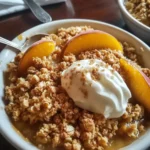This Mango Upside-Down Cake is the ultimate tropical dessert that combines the richness of caramelized mangoes with a soft, fluffy cake. The vibrant golden mango slices on top create an eye-catching presentation while offering a luscious, sweet flavor with every bite.
The best part? This cake is incredibly easy to make, requiring only a few simple ingredients you likely already have at home. It’s perfect for special occasions, weekend treats, or whenever you’re in the mood for a sweet, fruity indulgence. The balance between the tender cake and the caramelized mango is truly a winning combination!
Full Recipe:
-
1/4 cup (1/2 stick) unsalted butter
-
3/4 cup packed light brown sugar
-
2 ripe mangoes, peeled, pitted, and cut into 1/4-inch slices
-
1 1/2 cups all-purpose flour
-
1 teaspoon baking powder
-
1/4 teaspoon baking soda
-
1/4 teaspoon salt
-
1/2 cup unsalted butter, softened
-
1 cup granulated sugar
-
2 large eggs
-
1 teaspoon vanilla extract
-
1/2 cup buttermilk
Directions:
-
Preheat the oven to 350°F (175°C).
-
In a 9-inch round cake pan, melt 1/4 cup of butter over medium heat on the stove. Once melted, add the brown sugar, stirring until combined. Let the mixture simmer for 1-2 minutes.
-
Arrange the mango slices in a circular pattern in the bottom of the pan. Set the pan aside.
-
In a medium bowl, whisk together the flour, baking powder, baking soda, and salt.
-
In a separate large bowl, beat together the softened butter and granulated sugar until light and fluffy.
-
Add the eggs one at a time, beating well after each addition. Stir in the vanilla extract.
-
Gradually add the dry ingredients, alternating with the buttermilk, and mix until just combined.
-
Pour the batter over the mango slices in the cake pan, smoothing the top evenly.
-
Bake for 35-40 minutes, or until a toothpick inserted into the center of the cake comes out clean.
-
Let the cake cool in the pan for 5 minutes, then run a knife around the edge to loosen it. Invert the cake onto a serving platter.
-
Serve warm or at room temperature, and enjoy the caramelized mango goodness!
Prep Time: 20 minutes | Cooking Time: 40 minutes | Total Time: 1 hour
Kcal: 350 kcal | Servings: 8 servings
History and Origin
The upside-down cake has a long history, with its roots tracing back to the early 20th century in the United States. The concept of an “upside-down” cake refers to how it’s baked: the fruit and sugar topping is placed at the bottom of the pan before the batter is poured over it. When the cake is inverted after baking, the fruit topping becomes beautifully caramelized and forms a delicious glaze over the cake.
Traditionally, pineapple was the fruit of choice for upside-down cakes, a trend that became widely popular in the mid-1900s, especially after the introduction of canned pineapple. However, in many tropical regions, where mangoes are abundant, people began experimenting with different fruits, and the mango became a perfect candidate for this variation. Mango Upside-Down Cake brings a refreshing, tropical flair to the classic cake, celebrating the juicy, sweet, and slightly tangy flavors of the mango.
While the exact origin of Mango Upside-Down Cake isn’t as well-documented, the recipe likely evolved as a regional variation of the traditional pineapple cake, influenced by the availability of mangoes in tropical climates. Today, this cake is celebrated in various countries around the world, especially those where mangoes are a staple fruit, including parts of Asia, the Caribbean, and Latin America.
Variations and Adaptations
Mango Upside-Down Cake can be adapted in numerous ways, depending on personal preference or regional influences. Here are a few variations you can explore:
-
Tropical Fruit Medley: Instead of just mangoes, you can add other tropical fruits like pineapple, papaya, or kiwi to the cake. A mix of colorful fruits creates a beautiful and vibrant topping that brings a burst of different textures and flavors.
-
Coconut Infusion: Adding shredded coconut to the batter or sprinkling some on top of the mango layer can enhance the tropical theme of this cake, giving it an extra layer of flavor that complements the richness of the mangoes.
-
Vegan Version: For a vegan adaptation, you can swap the butter for coconut oil or vegan butter, and use a plant-based milk like almond or coconut milk instead of buttermilk. This will keep the cake light and dairy-free while still maintaining its tropical essence.
-
Gluten-Free: If you’re following a gluten-free diet, you can replace the all-purpose flour with a gluten-free flour blend. Make sure to check that your baking powder and other ingredients are also gluten-free.
-
Spiced Mango Cake: Adding a dash of cinnamon, nutmeg, or even a bit of cardamom to the cake batter can introduce a warm, spiced element that pairs beautifully with the tropical sweetness of the mangoes. This variation adds complexity to the flavor profile and gives the cake a more aromatic touch.
Nutritional Information
While Mango Upside-Down Cake is certainly indulgent, it also offers some nutritional benefits, thanks to the presence of fresh mangoes. Mangoes are an excellent source of vitamins A and C, both of which are essential for maintaining healthy skin, immune function, and eye health. The cake also provides a fair amount of carbohydrates, which give you an energy boost.
In terms of macronutrients, a typical serving of Mango Upside-Down Cake contains:
-
Calories: Around 350 kcal per slice
-
Carbohydrates: 55g
-
Protein: 3g
-
Fat: 15g
-
Fiber: 2g
-
Sugar: 30g
Mangoes are rich in antioxidants such as beta-carotene, which help protect the body against free radical damage. While the sugar content in the cake may be high due to the caramelization process, the natural sugars in the mangoes offer a healthier alternative to refined sugars.
For those looking to reduce sugar or fat intake, consider using a sugar substitute, such as stevia or monk fruit sweetener, and reducing the butter content. You can also try swapping buttermilk for a lighter, plant-based alternative like almond milk to make the cake less calorie-dense.
Serving Suggestions and Pairings
Mango Upside-Down Cake is versatile in how it can be served. Here are some creative ideas to elevate your dessert experience:
-
With Whipped Cream: A dollop of freshly whipped cream or coconut cream can add a rich, smooth contrast to the slightly tangy flavor of the mango topping. You can even infuse the cream with a hint of vanilla or coconut extract for added depth.
-
Ice Cream Pairing: Vanilla ice cream is a classic pairing for Mango Upside-Down Cake, but you can get more adventurous with coconut or even mango sorbet for a tropical twist.
-
Fresh Fruit Garnish: Serve the cake with a side of fresh, sliced mangoes or other tropical fruits like pineapple, kiwi, or passionfruit for an added layer of freshness and color.
-
Pairing with Beverages: This cake pairs wonderfully with iced tea or coconut water for a refreshing treat. For a more decadent option, a glass of dessert wine like Moscato or a tropical cocktail such as a piña colada will complement the cake’s sweet, fruity flavors.
-
Breakfast or Brunch Treat: Although this cake is typically served as a dessert, it can also be a delightful addition to a brunch or breakfast spread. Serve it with a strong cup of coffee or tea to start the day with a tropical flair.
Tips and Tricks for Success
To ensure your Mango Upside-Down Cake turns out perfectly every time, here are some expert tips:
-
Choosing the Right Mangoes: Make sure to use ripe but firm mangoes for this cake. Overripe mangoes can become too mushy when baked and may cause the cake to turn soggy. You want the mangoes to hold their shape while caramelizing in the oven.
-
Proper Caramelization: When making the caramelized topping, be sure to let the brown sugar and butter mixture simmer for just a few minutes before adding the mangoes. This will ensure a smooth, rich caramel that will coat the fruit nicely.
-
Even Cake Layer: To avoid an uneven batter spread, pour the cake batter gently over the fruit. Don’t be tempted to stir it, as this could disturb the fruit layer beneath.
-
Cooling Time: Allow the cake to cool for at least 10 minutes before flipping it over. This will prevent the mango topping from sticking to the pan and breaking apart.
Potential Health Benefits
Aside from the natural sweetness and tropical flavor of mangoes, this cake also provides some potential health benefits:
Advertisement
-
High in Vitamin C: Mangoes are a powerhouse of vitamin C, an essential nutrient that boosts the immune system and helps with the absorption of iron from plant-based foods.
-
Rich in Antioxidants: The antioxidants found in mangoes, including beta-carotene and polyphenols, may help reduce inflammation and fight oxidative stress, which can contribute to chronic diseases.
-
Digestive Health: Mangoes are a good source of dietary fiber, which aids in digestion and promotes gut health. The fiber content can help regulate bowel movements and prevent constipation.
While Mango Upside-Down Cake is not exactly a “health food,” the fruit it contains adds a nutritional boost compared to other desserts that rely on processed sugars and artificial flavorings. With a few modifications (such as using healthier oils or reducing sugar), this dessert can become a more balanced treat.
Conclusion
Mango Upside-Down Cake is a show-stopping dessert that combines the best of tropical flavors with the comforting appeal of a classic cake. Whether you’re celebrating a special occasion, hosting a summer dinner, or simply craving a slice of something sweet, this cake is sure to delight. Its rich, caramelized mango topping paired with the light and fluffy cake creates a perfect harmony of flavors. Try it out and let the tropical magic unfold in your kitchen!






